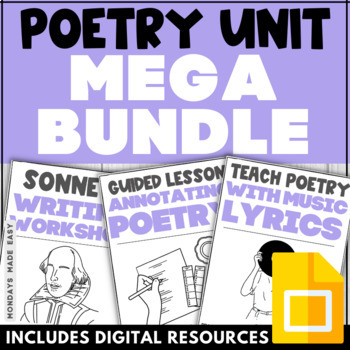High School Poetry Unit - Reading, Annotating, Analyzing, and Writing Poetry
- Zip
- Google Apps™

What educators are saying
Products in this Bundle (9)
showing 1-5 of 9 products
Description
This modern high school poetry unit will hook even your most reluctant learners! This bundle provides over 300 pages of materials including slideshow lessons, vocabulary activities, poetry writing workshops, assignments, rubrics, and more. Suitable for distance learning and Google Classroom®!
⚡️ Save over 30% with the bundled discount! ⚡️
Included in this High School Poetry Unit:
1. Elements of Poetry Anchor Chart and Introduction to Poetry Slideshow Lesson
This lesson explores common poetic forms and solidifies students' understanding of the elements of poetry. Students will be prompted to call forward their background knowledge of poetry from previous learning. This slideshow will also introduce key terminology, including meter, verse, and stanza. Finally, this lesson will scaffold the process of reading and interpreting poetry using a provided poem.
Students will then complete the elements of poetry vocabulary activity, which will introduce 16 different poetic elements and forms. They will be prompted to find a formal definition for each poetic form and to paraphrase this definition to solidify their understanding. They will also be prompted to find an example to demonstrate each form.
2. Poetic Devices Posters - Figurative Language Anchor Chart
Students will search for poetic device definitions and examples using the poetic device posters provided! Students will feel confident analyzing and interpreting poetic devices in literature and poetry after completing this activity. Once this activity is completed, you can also utilize these vocabulary worksheets as a classroom poetic devices anchor chart.
3. Literary Device Matching Game - Poetic Device Game Cards with Examples
Explore poetic devices and engage students with pop-culture references using this Literary Device Matching Game! These poetic device game cards showcase examples from both classic literature and contemporary song lyrics. Includes 16 literary device vocabulary terms and 32 examples.
4. How to Annotate Poetry - Close Reading Lesson and Annotation Worksheets
Teach students how to annotate poetry using this close reading lesson! This lesson uses annotating poetry examples to model the process of close reading and annotation. Students will practice annotating poetry and meter using Langston Hughes’ classic poem, “The Negro Speaks of Rivers.” This resource also provides an Annotating Poetry Bookmark which serves as a personal anchor chart for students.
5. Song Lyric Analysis Lesson - Teaching Poetry Analysis Through Song Lyrics
Make connections between your language arts curriculum and your students' personal interests with this poetry lesson! Students will explore poetry through popular culture by analyzing song lyrics with the resources provided. This lesson includes a slideshow lesson, informational handout, a practice annotation worksheet, analysis graphic organizer, and an application activity that can be used with any song lyrics.
6. Free Verse Poetry Lesson - Assignment with Rubric and Pages for Blackout Poems
Explore free verse poetry with this poetry writing workshop! Free verse poetry is a wonderful way to encourage creative expression and relate poetry to popular culture and students’ personal interests. Students will read modern free verse poems with the option to write blackout poetry, a collage poem, or an illustrative poem.
7. Haiku Poetry Lesson - How to Write a Haiku Assignment Haiku Templates and Rubric
Students will learn about the history of haiku poetry and explore different haiku poems before composing their own series of 8 haiku. You can use the differentiated haiku templates and writing prompts for this assignment, as well as the haiku rubric for assessment.
8. Sonnet Writing Lesson - Shakespearean and Petrarchan Sonnet Templates and Rubric
Students will be guided through a Sonnet Writing “Deep-Dive” as they explore the history and form of a sonnet poem. They will practice identifying iambic pentameter and distinguish between two famous sonnet forms: Petrarchan and Shakespearean Sonnets. They will then compose their own sonnets using the sonnet templates provided! You can use the sonnet rubric to assess their writing.
⭒ For classrooms utilizing Google Classroom® ⭒
To access the digital version of these lessons, simply follow the instructions within each resource to copy the files directly to your Google Drive®.
✨ Kindly note that due to copyright restrictions, these resources are not editable. This is a common practice within the TPT marketplace in order to protect the clip artists and software providers that have authorized their intellectual property for the development of this resource.
⭐ Customer Tip! ⭐
Want FREE CREDIT to go towards purchases? Make sure to offer feedback for your downloads! Follow these instructions below:
- Go to your "My Purchases" page to find a "Provide Feedback" button next to each download.
- Follow this link to offer a quick rating and leave a short comment for the product. Each time you give feedback, TPT gives you feedback credits that you use to lower the cost of your future purchases!
- Your feedback is important to me as it helps me to continually improve my products and ensure they are meeting your needs!
Follow me! Be the first to know about product launches, sales, discounts, and free giveaways:
➾ The Blog
For questions, collaborations, or other concerns:
✉ Contact me: hello@mondaysmadeeasy.com
Access my Free Resource Library!
Mondays Made Easy is committed to the continual improvement of resources to meet the current needs of teachers. This product was last updated on April 3, 2024.





